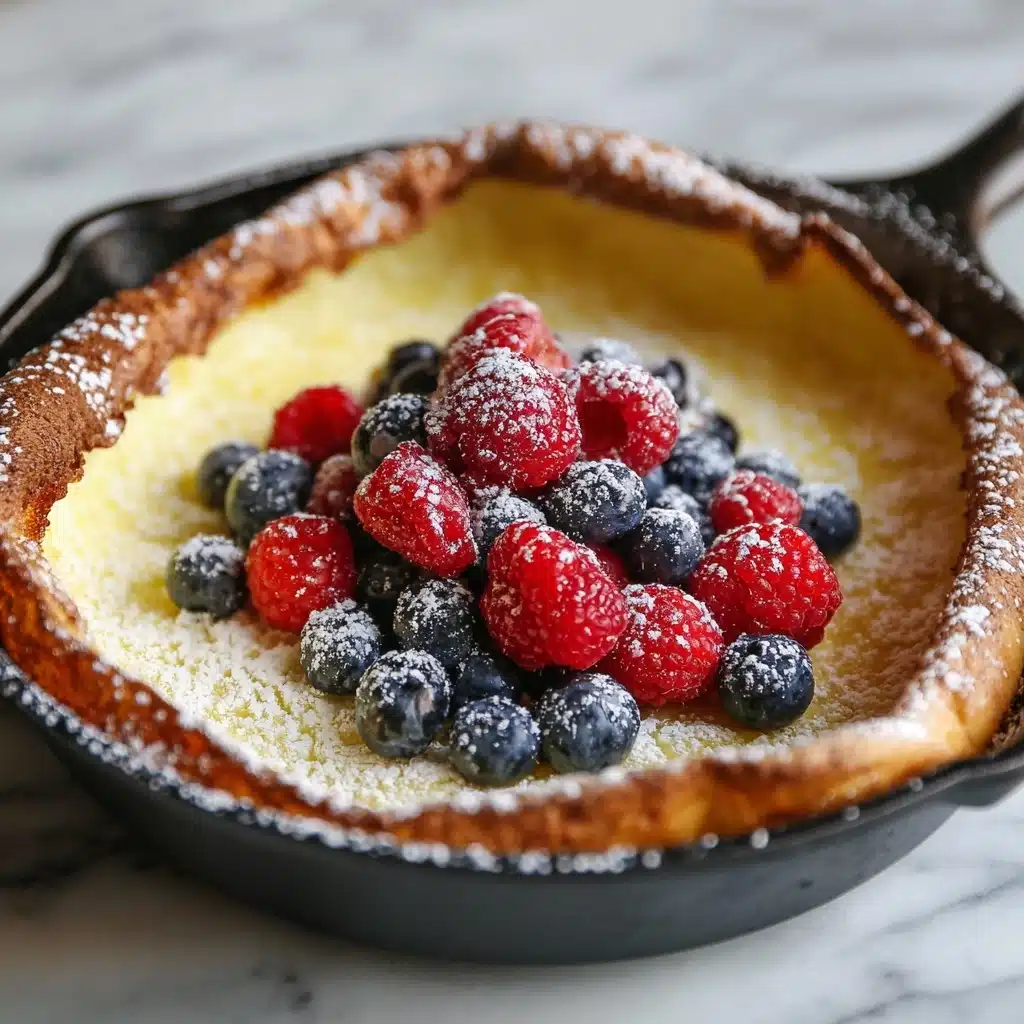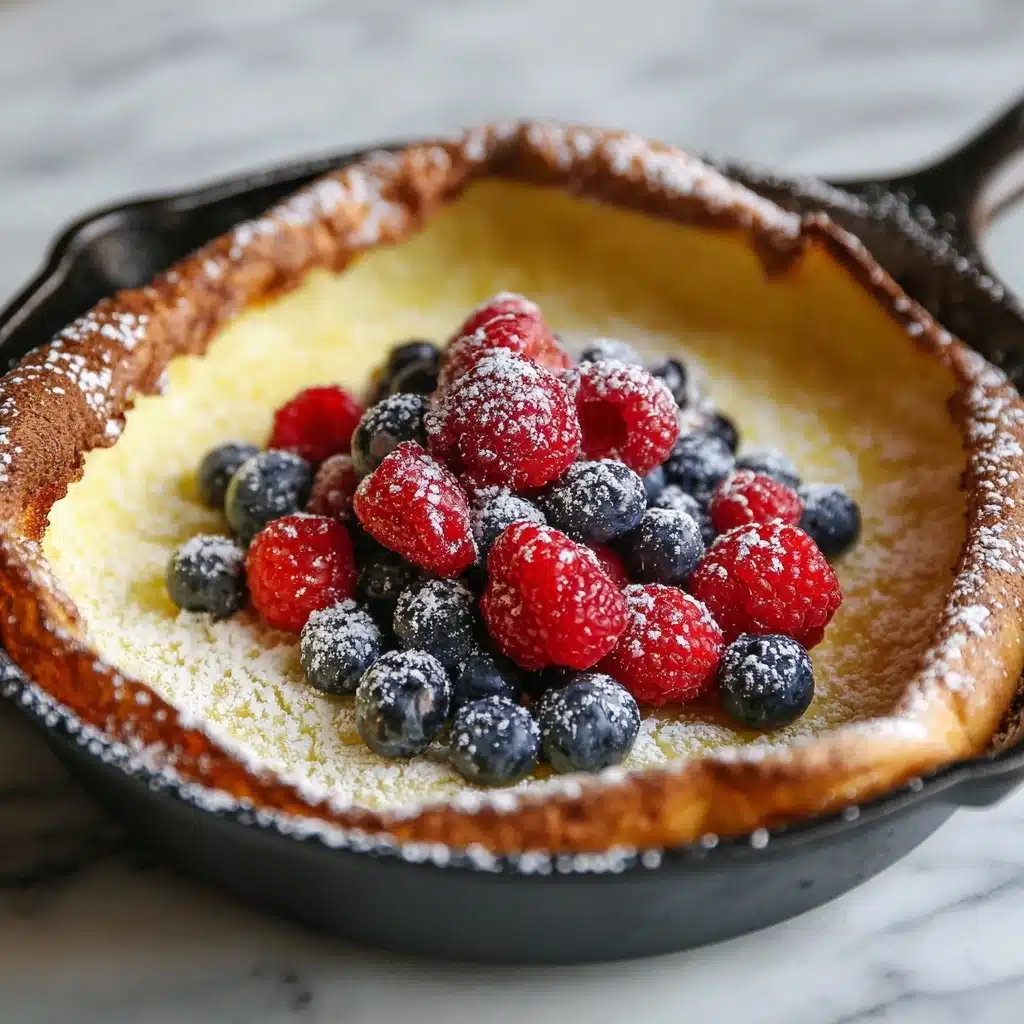If you’ve ever craved a breakfast that feels both impressive and effortlessly cozy, the Dutch Baby is about to become your go-to recipe. This puffy oven pancake is pure culinary magic: it starts out as a simple batter, then transforms in the oven into a golden, billowy wonder with crisp edges and a custardy center. Whether dusted with powdered sugar, drizzled with fresh lemon, or loaded with vibrant fruit, a Dutch Baby is the kind of dish you’ll want to share with loved ones again and again—though it’s so delicious, you might be tempted to keep the whole skillet for yourself.
Ingredients You’ll Need
Let’s talk about the magic behind every Dutch Baby: the beauty of this recipe lies in its handful of common kitchen staples, each doing something truly special. With just a few simple components, you unlock a breakfast that tastes miles fancier than the effort required.
- Eggs: The backbone of the Dutch Baby’s puff—using large eggs will give your pancake its signature rise and custardy texture.
- Whole milk: Adds richness and ensures the interior stays wonderfully tender, not dry.
- All-purpose flour: This gives your Dutch Baby structure and helps catch those lovely air bubbles for that classic puff.
- Granulated sugar: Just a touch brings out a gentle sweetness without overpowering the other flavors.
- Vanilla extract: Infuses the batter with a warm, aromatic note that pairs perfectly with sweet toppings.
- Salt: A little seasoning boosts the flavors and keeps the pancake from tasting flat.
- Unsalted butter: For coating the pan, lending both flavor and those lacy, golden-brown edges everyone adores.
- Powdered sugar, lemon wedges, or fresh fruit (for serving): All are classic, irresistible ways to finish your Dutch Baby.
How to Make Dutch Baby
Step 1: Preheat Your Oven (and Skillet)
Start by preheating your oven to 425°F (220°C), and pop a 10-inch cast iron skillet or any sturdy, oven-safe pan right inside as it comes to temperature. Getting your pan nice and hot from the get-go is the secret to achieving that dramatic rise when the batter hits the surface—you’ll hear a satisfying sizzle if you’re doing it right!
Step 2: Blend the Batter
While your oven and skillet are heating, grab a blender. Combine the eggs, whole milk, flour, sugar, vanilla extract, and salt. Give it a good whirl for about 20 seconds or so until everything is silky-smooth and slightly frothy. This thorough blending not only ensures a lump-free batter but also incorporates air for an extra puffy Dutch Baby.
Step 3: Let the Batter Rest
Letting the batter rest for several minutes while the oven heats is a simple trick with big payoffs. This short pause allows the flour to fully hydrate and the air bubbles to settle just right, resulting in a fluffier, more tender Dutch Baby pancake.
Step 4: Swirl the Butter in the Hot Pan
Once your skillet is rocket-hot, carefully remove it from the oven (use mitts!), and drop in the unsalted butter. It’ll melt instantly—green light to swirl it all around so the pan is fully coated, even up the sides. This buttery layer not only prevents sticking but also guarantees those beautiful, crispy edges.
Step 5: Pour and Bake
Immediately pour your rested batter into the gleaming, buttery pan. Don’t hesitate—act quickly to keep the heat! Slide the pan back into the oven and bake for 18 to 22 minutes without opening the oven door. Watch through the oven light as your Dutch Baby balloons into a golden, cloud-like masterpiece.
Step 6: Finish and Serve
When your Dutch Baby is gloriously puffed and browned at the edges, carefully remove it from the oven. The pancake will deflate just slightly as it cools—totally normal, and part of its charm! Now all that’s left is to decide how you want to finish and serve your Dutch Baby.
How to Serve Dutch Baby

Garnishes
Serving a Dutch Baby is all about playing with textures and flavors. A generous snowfall of powdered sugar is classic, adding just the right touch of sweetness. A squeeze of fresh lemon brings bright acidity and makes every bite sing. You can also pile on fresh berries, sliced peaches, or even juicy stone fruits for a nostalgic, summery flair.
Side Dishes
Pair your Dutch Baby with breakfast sides that balance its rich, eggy personality. Think crispy bacon strips, herby breakfast sausage, or a crunchy green salad if you want to feel virtuous. For brunch spreads, a bowl of yogurt or a dish of citrus segments alongside will elevate every plate.
Creative Ways to Present
For a playful twist, try making mini Dutch Babies in individual ramekins or muffin tins—the wow factor is instant and they’re perfect for brunch parties. If you’re feeling savory, skip the sugar in your batter and top with cheese, sautéed greens, or smoked salmon for a Dutch Baby experience that covers all the flavor bases.
Make Ahead and Storage
Storing Leftovers
Leftover Dutch Baby (if you somehow have any!) will keep in an airtight container in the refrigerator for up to two days. The texture will soften a bit, but those delicious flavors stay put.
Freezing
You can freeze slices of Dutch Baby for longer storage. Just wrap individual portions tightly in plastic wrap and pop them into a freezer bag—they’ll keep well for up to one month. Thaw in the fridge overnight before reheating for best results.
Reheating
To revive your Dutch Baby, reheat slices in a 350°F (175°C) oven for about 8–10 minutes, or until warmed through. While the pancake won’t puff quite like the original bake, it’ll regain some crispness and all of that irresistible flavor in every bite.
FAQs
Why did my Dutch Baby deflate after baking?
A little deflating is expected—Dutch Babies are naturally dramatic out of the oven but settle as they cool. It’s totally normal and doesn’t affect the taste at all!
Can I make a dairy-free Dutch Baby?
Absolutely! You can replace the whole milk with your favorite plant-based milk and use dairy-free butter. The final texture may be slightly different, but you’ll still get a delicious, impressive result.
What if I don’t have a cast iron skillet?
A heavy, oven-safe nonstick or stainless steel pan works just fine. Just be sure it can stand up to high oven temperatures and has sturdy sides to help the Dutch Baby rise.
Can I double the recipe for a bigger crowd?
You sure can! Use a larger skillet (like a 12-inch), or divide the batter between two pans so the Dutch Baby still gets that glorious rise. Just watch the bake time—slightly longer if using a bigger pan.
Is there a savory version of Dutch Baby?
Definitely! Leave out the sugar and vanilla extract in the batter, then top with grated cheese, fresh herbs, sautéed vegetables, or even smoked salmon for a brunch-friendly twist on the classic Dutch Baby.
Final Thoughts
Trust me: once you try making a Dutch Baby, it’ll win you over every time. It’s the kind of breakfast that’s always met with smiles and makes even an ordinary weekend feel special. So preheat that pan, grab your ingredients, and treat yourself (and your favorite people) to some golden, puffy pancake magic!
PrintDutch Baby Recipe
This Dutch Baby recipe creates a delightful puffy pancake that’s perfect for a special breakfast or brunch. With a crispy exterior and a soft, custardy interior, it’s a treat with powdered sugar, lemon, or fresh fruit.
- Prep Time: 5 minutes
- Cook Time: 20 minutes
- Total Time: 25 minutes
- Yield: 4 servings 1x
- Category: Breakfast, Brunch
- Method: Baking
- Cuisine: German-American
- Diet: Vegetarian
Ingredients
Batter:
- 3 large eggs
- 2/3 cup whole milk
- 2/3 cup all-purpose flour
- 1 tablespoon granulated sugar
- 1/2 teaspoon vanilla extract
- 1/4 teaspoon salt
For Pan:
- 2 tablespoons unsalted butter
- powdered sugar
- lemon wedges, or fresh fruit for serving
Instructions
- Preheat the Oven: Preheat oven to 425°F (220°C). Place a 10-inch cast iron skillet or ovenproof pan in the oven to heat.
- Prepare the Batter: In a blender, combine the eggs, milk, flour, sugar, vanilla extract, and salt. Blend until smooth, about 20 seconds. Let the batter rest while the pan heats.
- Prepare the Pan: Carefully remove the hot skillet from the oven, add the butter, and swirl to coat the bottom and sides.
- Bake the Dutch Baby: Immediately pour the batter into the pan and return it to the oven. Bake for 18–22 minutes, or until puffed and golden brown. Avoid opening the oven during baking.
- Serve: Once done, remove from oven and serve immediately with powdered sugar, lemon juice, or fresh fruit.
Notes
- For a savory version, skip the sugar and vanilla and top with cheese, herbs, or sautéed vegetables.
- The puff will deflate slightly after coming out of the oven—that’s normal.
Nutrition
- Serving Size: 1 slice
- Calories: 180
- Sugar: 5g
- Sodium: 180mg
- Fat: 9g
- Saturated Fat: 5g
- Unsaturated Fat: 3g
- Trans Fat: 0g
- Carbohydrates: 18g
- Fiber: 0g
- Protein: 6g
- Cholesterol: 140mg




